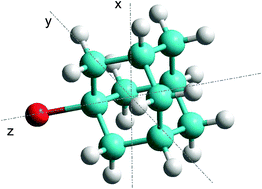On the microscopic mechanism behind the purely orientational disorder–disorder transition in the plastic phase of 1-chloroadamantane†
Abstract
Globular molecules of 1-chloroadamantane form a plastic phase in which the molecules rotate in a restrained way, but with their centers of mass forming a crystalline ordered lattice. Plastic phases can be regarded as test cases for the study of disordered phases since, contrary to what happens in the liquid phase, there is a lack of stochastic translational degrees of freedom. When the temperature is increased, a hump in the specific heat curve is observed indicating a change in the energetic footprint of the dynamics of the molecules. This change takes place without a change in the symmetry of the crystalline lattice, i.e. no first-order transition is observed between temperatures below and above the calorimetric hump. This implies that subtle changes in the dynamics of the disordered plastic phase concerning purely orientational degrees of freedom should appear at the thermodynamic anomaly. Accordingly, we describe, for the first time, the microscopic mechanisms behind a disorder–disorder transition through the analysis of neutron diffraction and QENS experiments. The results evince a change in the molecular rotational dynamics accompanied by a continuous change in density.


 Please wait while we load your content...
Please wait while we load your content...